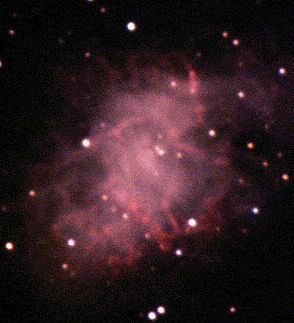Credit & Copyright: The Electronic Universe Project
Explanation:
In the year 1054 a star in the constellation of Taurus exploded in a
spectacular
supernova so bright it appeared to
dominate the sky except for the Sun and Moon for many days.
It left behind one of the most
brilliant nebulae, listed first in
Charles Messier's list of nebulous sky
objects. Today we know that the center of the nebula houses the remnant
of the explosion: a spinning
neutron star called a pulsar.
The Crab pulsar
is visible in almost every part of the electromagnetic spectrum, and has
been a useful astronomical tool. It is still unclear how the the pulsar
emits the light that we see.
For more information on M1 see The Electronic Universe Project's write-up.
Many images of Messier objects can be found in The Electronic Universe Project's The Galaxy Gallery: Messier Objects.
1999 2000 2001 2002 2003 2004 2005 2006 2007 2008 2009 2010 2011 2012 2013 2014 2015 2016 2017 2018 2019 2020 2021 2022 2023 2024 2025 |
Январь Февраль Март Апрель Май Июнь Июль Август Сентябрь Октябрь Ноябрь Декабрь |
NASA Web Site Statements, Warnings, and Disclaimers
NASA Official: Jay Norris. Specific rights apply.
A service of: LHEA at NASA / GSFC
& Michigan Tech. U.
|
Публикации с ключевыми словами:
Crab Nebula - M 1 - Крабовидная туманность - пульсар в Крабе
Публикации со словами: Crab Nebula - M 1 - Крабовидная туманность - пульсар в Крабе | |
См. также:
Все публикации на ту же тему >> | |
